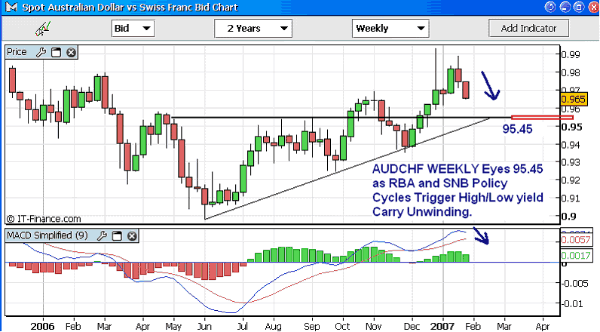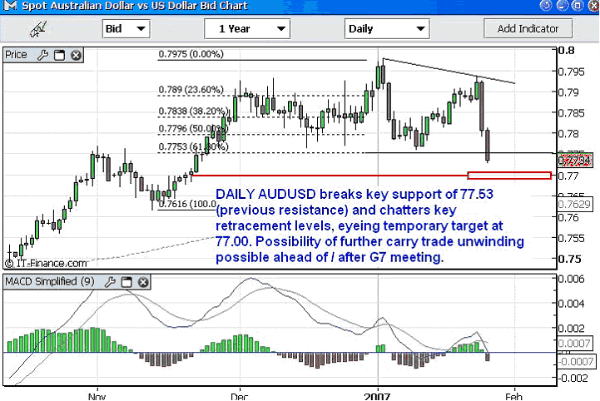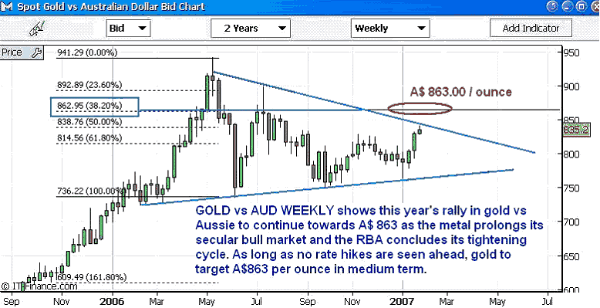Currency Market Forecast - Further Aussie Dollar (AUD) Unwinding Ahead due to softer Inflation
Currencies / US Dollar Jan 26, 2007 - 03:33 PM GMTBy: Ashraf_Laidi
 This week's softer than expected consumer inflation figures from Australia have eroded chances of a February rate hike and may have finally concluded the 4 ½ year old tightening cycle adopted by the Reserve Bank of Australia, which lifted interest rates from 4.25% to 6.25%. The headline CPI slowed to 3.3% in y/y in Q4 from 3.9% in Q3, undershooting expectations of a 3.6% reading. Although the core CPI (excluding volatile items) edged up to 2.7% from 2.6%, the seasonally adjusted weighted median CPI slipped to 3.0% from 3.2%. Markets were especially caught off guard by the 0.1% decline q/q, which was the first decrease in 8 years. The soft CPI report was clearly a result of falling energy and commodity prices, which triggered a 12.4% drop in gasoline costs and a 5.2% in fruit prices. But the report was instrumental in dampening probabilities of a February rate hike from as much as 80% to less than 15%.
This week's softer than expected consumer inflation figures from Australia have eroded chances of a February rate hike and may have finally concluded the 4 ½ year old tightening cycle adopted by the Reserve Bank of Australia, which lifted interest rates from 4.25% to 6.25%. The headline CPI slowed to 3.3% in y/y in Q4 from 3.9% in Q3, undershooting expectations of a 3.6% reading. Although the core CPI (excluding volatile items) edged up to 2.7% from 2.6%, the seasonally adjusted weighted median CPI slipped to 3.0% from 3.2%. Markets were especially caught off guard by the 0.1% decline q/q, which was the first decrease in 8 years. The soft CPI report was clearly a result of falling energy and commodity prices, which triggered a 12.4% drop in gasoline costs and a 5.2% in fruit prices. But the report was instrumental in dampening probabilities of a February rate hike from as much as 80% to less than 15%.
But it's not all about slowing inflation. The severe draught has weighed on the economy, causing Q3 GDP growth to slow to 0.3% q/q, its lowest rate since Q2 2003. Retail sales have also slowed while rising interest rates may once again start to burden consumers amid the general cooling. The important role of slowing inflation on monetary policy is that it serves as the main counterpoint to tightening labor markets, which have been strengthened by a 4.6% unemployment rate, the lowest in 30 years. Albeit volatile, Australia's job figures continue to show a strong participation rate of 64.9%. But with inflation cooling, GDP growth struggling below 1.0% and interest rates at their highest in 8 years, the case for further monetary tightening weakens by the day.
The combination of weakening energy prices and a sharp reversal in expectations from a February rate hike earlier this week to no hike after Wednesday's CPI figures has triggered an all round assault on the Australian dollar, resurrecting calls for unwinding in FX carry trades. The unwinding was short-lived in the yen crosses due to remaining uncertainty over the Japanese interest rates.
While the aforementioned analysis suggests further declines in the Australian dollar, the following charts present the case for further downfall. Here are a few cases:
AUDEUR WEEKLY
The AUDEUR cross rate suggests further downside potential considering heightened certainty for at least 25 bps of tightening from the European Central Bank this quarter as communicated via the officials' consistently hawkish rhetoric. With consumer demand and business confidence continuing to show signs of strength, the growth arguments for further rate hikes are added to the inflation arguments. The aforementioned prospects for Australian monetary policy suggest further downside, with 59.40 and 59.00 as the next targets from the current 59.75.

AUDUSD DAILY
Although the pair has plunged by 2 cents in two days, breaking the major 77.60 support (formerly a major resistance) to 77.3, we expect prolonged selling towards the 77.00 as an initial target. Next week's FOMC meeting is expected to produce a relatively optimistic statement, which could make the Aussie one of the primary casualties of a USD rally. The only major risk to this forecast is a sharp run up in oil prices --over $2.00 per day -- which could elevate the pair towards the 77.60 resistance.

AUDCHF WEEKLY
As the Swiss National Bank continues expressing concern over franc weakness, a March rate hike remains firmly cemented in the works. In the event that evidence of a slowing Australian economy persists, markets may even begin pricing a rate cut later in the year, which could trigger sharp bouts of unwinding in the AUDCHF carry trade. The hefty yield differential of 4.25% in favor of the AUD is the reason why the chart below has yet to show further downside. With both the MACD line and signal lines above zero, there're appears a strong likelihood for prolonged selling to call up the 96 centimes 95.45 centimes levels from the current 96.50. Upside capped at 97.20.

GOLDAUD WEEKLY
Charting gold against the Aussie highlights the ensuing broad weakness in the Australian dollar, as the weekly chart has not shown significant decline since last September. Gold's resilience against the high yielding currency, and its approach towards the 8-month trend line resistance increases chances of a breach past A$ 839 and onto the A$863 target.

By Ashraf Laidi
CMC Markets NA
Ashraf Laidi is the Chief FX Analyst at CMC Markets NA. This publication is intended to be used for information purposes only and does not constitute investment advice. CMC Markets (US) LLC is registered as a Futures Commission Merchant with the Commodity Futures Trading Commission and is a member of the National Futures Association.
© 2005-2022 http://www.MarketOracle.co.uk - The Market Oracle is a FREE Daily Financial Markets Analysis & Forecasting online publication.


